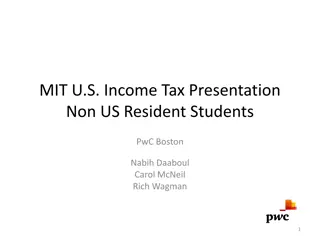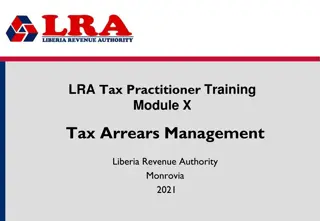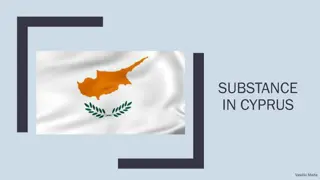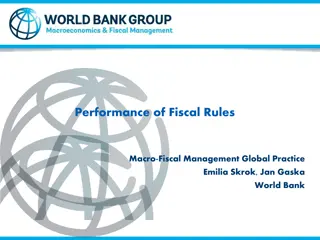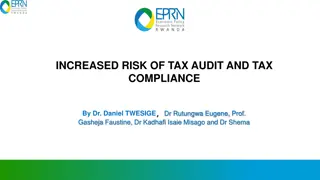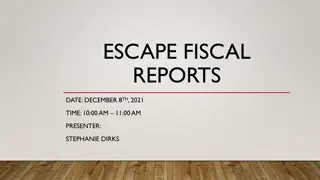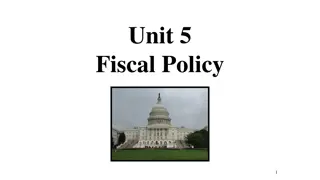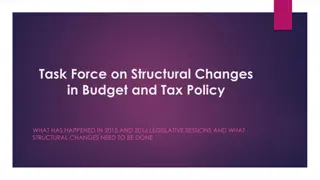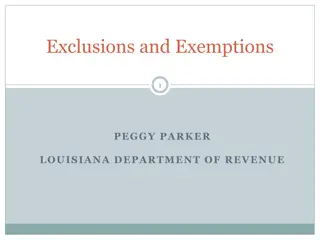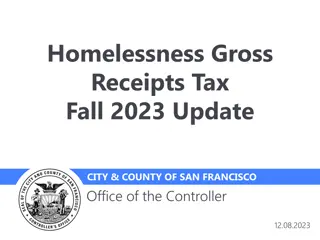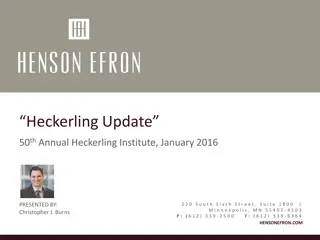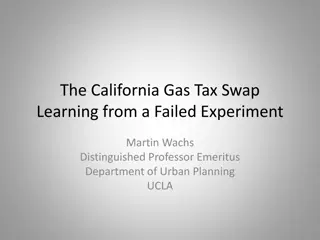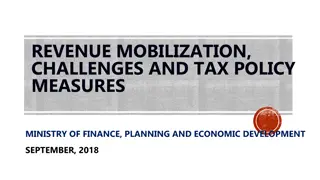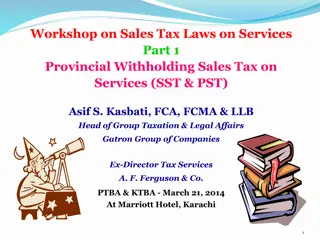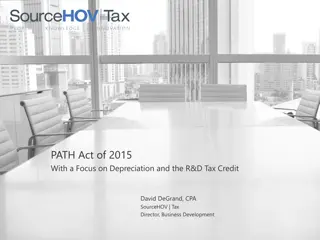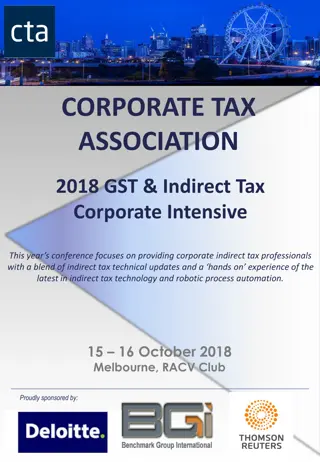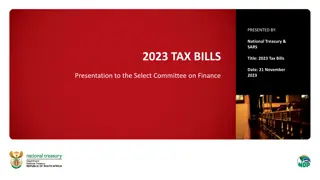Towards a Sustainable Fiscal Solution: A Small Tax and a Moderate Dividend
Alaska's fiscal challenges post-2014 oil price collapse led to budget cuts and restructuring of Permanent Fund earnings. Representative Adam Wool's proposal aims to balance the budget by adjusting the dividend formula and introducing new revenues through a small tax. The Ways and Means Committee explores the need for additional revenue sources and the ongoing deficits faced by Alaska, highlighting the importance of resolving the dividend question. The past decade has seen revenue declines, budget cuts, and the utilization of Permanent Fund earnings.
- Sustainable fiscal solution
- Alaska budget
- Adam Wool proposal
- Permanent Fund earnings
- Revenue restructuring
Download Presentation

Please find below an Image/Link to download the presentation.
The content on the website is provided AS IS for your information and personal use only. It may not be sold, licensed, or shared on other websites without obtaining consent from the author. Download presentation by click this link. If you encounter any issues during the download, it is possible that the publisher has removed the file from their server.
E N D
Presentation Transcript
A Small Tax and a Moderate Dividend: Towards a Sustainable Fiscal Solution Representative Adam Wool Representative Adam Wool Presentation to the House Judiciary Committee Presentation to the House Judiciary Committee June 9, 2021 June 9, 2021 1
Where We Are Where We Are After oil prices collapsed in late 2014, Alaska needed to accomplish four things in order to establish a sustainable budget: 1. Major budget cuts (mostly implemented 2015-2018). 2. Structured use of Permanent Fund earnings (SB26 passed for FY2019). 3. Revised Permanent Fund Dividend formula to work with new POMV and our fiscal reality. (Formulas were passed by both the House and Senate in separate versions of SB26, but neither survived the conference committee. Other formulas have been since proposed in several bills.) 4. New revenues to fill any remaining gap. Thus far, only #1 and #2 have been accomplished. My proposal resolves the rest. 2
What is needed? What is needed? Depending on oil prices, Permanent Fund earnings, and future budget sizes, the next couple budgets are likely to be approximately balanced with a relatively small (~$500) Permanent Fund Dividend. Unless massive budget cuts can be achieved, two major changes must be made to balance Alaska s budget for the foreseeable future and form the centerpiece of a sustainable fiscal plan: 1. Restructuring the annual dividend formula to set future dividends to about $1,000 per Alaskan 2. A combination of new revenues (most likely a broad-based tax on individuals) raising approximately $500 million If higher dividends are desired, revenues will similarly need to be higher. but first a little background 3
Ways and Means Committee Process Told the Story Ways and Means Committee Process Told the Story Revenue declines, beginning in 2014 Budget cuts and major draw-down of savings Introduction of POMV as a central revenue feature Ongoing structural deficits Lack of resolution of the Dividend question Alaskans pay the lowest state and local taxes among the 50 states Once a consensus is reached that we need additional revenue, new questions emerge: Pros and Cons of Income Tax vs. Sales Tax vs. Other How much revenue to raise / how large should the dividend be? Structural and technical details of the bill 4
Last 10 years: revenue declines, budget cuts, and Last 10 years: revenue declines, budget cuts, and (beginning in FY19), use of Permanent Fund earnings (beginning in FY19), use of Permanent Fund earnings 5 Source: Legislative Finance Presentation to House Ways and Means, 3/30/21
Most of the savings that were drawn down 2014 Most of the savings that were drawn down 2014- -2021 were set aside during the high oil price years 2007 were set aside during the high oil price years 2007- -2013 2021 2013 6
Permanent Fund Corporations Forecast Permanent Fund Corporation s Forecast Permanent Fund earnings will make up roughly 2/3 of UGF revenue in the foreseeable future 7 Source: APFC Presentation to House Ways and Means, 4/1/21
Even with higher oil revenue in the Spring forecast, Even with higher oil revenue in the Spring forecast, the 10 the 10- -year plan shows large ongoing shortfalls year plan shows large ongoing shortfalls 8 Source: Office of Management and Budget Presentation to House Ways and Means, 3/30/21
The revised 10 The revised 10- -year plan introduced this special session includes year plan introduced this special session includes larger future POMV draws based on recent market gains larger future POMV draws based on recent market gains After five years (FY2027), when the higher fund value is fully incorporated into the lookback period for the POMV, the forecasted draw is $650 million higher than it was in March. 9 Source: Office of Management and Budget Presentation to House Judiciary, 5/24/21
A Perfect Storm is required for all these forecasts to work A Perfect Storm is required for all these forecasts to work 1. 2. 3. No major market correction in the next 9 years Oil prices steadily increasing towards $71 / bbl in 2030 Three more years of likely unobtainable operating budget cuts and ongoing minimal capital budgets, with below-inflation growth thereafter Legislative Finance s baseline budget is very different than the Governor s: 10 Source: Legislative Finance Presentation to House Judiciary, 6/2/21
50/50 Dividend Without Revenue Crashes the System 50/50 Dividend Without Revenue Crashes the System 11 Source: Legislative Finance Presentation to House Ways and Means, 4/6/21
Alaskas current revenue structure hasnt kept pace Alaska s current revenue structure hasn t kept pace with our changing economy with our changing economy 12 Source: DCCED Commissioner Mike Navarre, Presentation to House Finance 3/20/18
Alaskans pay less state and local tax than any other state Alaskans pay less state and local tax than any other state Alaska is 5.8% in combined state and local taxes Next lowest are Wyoming and Tennessee at 7.0% If the PFD ($1,606 in 2019) was included as a negative tax , Alaska s effective state and local tax rate would be about 1.7% 13 Source: Tax Foundation, Presentation to House Ways and Means, 4/15/21
Adding a moderate tax would not change that much Adding a moderate tax would not change that much Black bar represents $700 million in new and increased taxes (based on House Income Tax bill, 2017) Even with that tax added, we d still be 2nd lowest in the country (Per-capita state taxation) 14 Source data: Mouhcine Guettabi, ISER
Revenue Options: Sales vs. Income Revenue Options: Sales vs. Income The great majority pay less with an income tax vs. a sales tax The 81st percentile Alaska household makes about $100,000 / year 15 Source: Institute on Taxation and Economic Policy, Presentation to House Ways and Means, 4/10/21
Permanent Fund Changes Permanent Fund Changes Replaces the current Dividend formula to one based on 10% of the annual Percent of Market Value draw plus 30% of oil and gas royalties FY2023 POMV Draw: 10% towards the dividend $3,194 million $319 million FY2023 Royalty Forecast ($62 oil) $1,192 million 30% towards the dividend $358 million Total Dividend Funding Per Capita Dividend $677 million $995 The roughly $1,000 dividend should grow to $1,200-$1,300 by 2030 17
Permanent Fund Changes Permanent Fund Changes Future dividends are tied to both our accumulated savings (the permanent fund itself) as well as the health of the industry (oil royalties) Other Permanent Fund changes in the bill Repeals the statutory 50% corpus deposit of royalties from leases signed after 1979 o The 25% constitutional requirement remains: 25% of all royalties, bonus payments, etc. will continue to be deposited. o The additional 25% is approximately $57 million in FY2021; this amount would remain in the general fund available for appropriation Repeals the Amerada Hess set-aside, where the annual earnings on a specific $420 million settlement from the early 1990s are excluded from the POMV and dividend calculations o About $27 million / year currently goes to the Capital Income Fund 18
Income Tax Income Tax Flat rate 2.5% tax based on federal Adjusted Gross Income (AGI) Metric that is the most widely used among states with income taxes Includes all income: wages, self employment, earnings of partnerships and S-corps, capital gains, retirement, etc. Adjustments to income (i.e. non-taxed items) include retirement contributions, student loan interest, and alimony payments. So-called itemized deductions, like mortgage interest, are taken after AGI and would therefore be taxed Standard Deduction tied to federal code: First $12,550 (single), $18,800 (head of household), and $25,100 (joint) is not taxed PFD payments are also non-taxable income Largely eliminates the tax burden on lower-income Alaskans and provides a form of means testing for the dividend 19
Revenue and Impacts Revenue and Impacts The LB&A Committee hired the Institute on Taxation and Economic Policy (ITEP) last fall, to look at several different flat rate income tax options The original bill (2.5%, $10k/$20k standard deduction) was Option 2 The consultant estimated $581 million annual revenue (Fiscal note: $580 million) The amended bill, with a higher standard deduction, is estimated at $545 million 20 Source: ITEP, Comparing Flat-Rate Income Tax Options for Alaska, December 2020, page 38
Even after paying a tax, most Alaskans would still receive a dividend Even after paying a tax, most Alaskans would still receive a dividend The forecasted FY2023 POMV draw is just under $3.2 billion A dividend based on 10% of that plus 30% of oil royalties would be a $677 million appropriation, working out to roughly a $995 dividend per person For the majority of Alaskans, their tax burden will be less than their dividend, meaning they will still receive a net payment from the state Taxpayer Type $25,000 $50,000 $100,000 $200,000 Dividend Tax Net Dividend Dividend Tax Net Dividend Dividend Tax Net Dividend Dividend Tax Net Dividend $995 $286 $709 $1,990 $105 $1,885 $1,990 $0 $1,990 $3,980 $0 $3,980 $995 $911 $84 $1,990 $730 $1,260 $1,990 $573 $1,417 $3,980 $523 $3,457 $995 $2,161 ($1,166) $1,990 $1,980 $10 $1,990 $1,823 $167 $3,980 $1,773 $2,207 $995 $4,661 ($3,666) $1,990 $4,480 ($2,490) $1,990 $4,323 ($2,333) $3,980 $4,273 ($293) Single Person Tax Liability in 2023 for Different Household Types and Income Levels Single Parent / 1 Kid Married Couple Married / 2 Kids 21
Other options: partial list of specific dividend proposals Other options: partial list of specific dividend proposals from the last few years from the last few years Est. 2021 Dividend Year Bill Sponsor PF Draw Formula Dividend Formula Note Most current oil revenue deposted into the Permanent Fund 2016 SB128 Gov. Walker $3.3 billion fixed + inflation 50% of oil royalty $1,000 2017 2017 SB21 SB26 Sen. Stedman Gov. Walker 4.5% POMV / prev 5 yrs 5.25% / first 5 of prev 6 yrs 5.25% / first 5 of prev 6 yrs; to 5% after 3 years 5.25% / first 5 of prev 6 yrs; to 5% after 3 years 5.25% / first 5 of prev 6 yrs; to 5% after 3 years 50% of POMV 20% POMV + 20% oil royalty $2,100 $1,300 Original introduced version 2017 SB26 Gov. Walker 25% of POMV $1,200 Senate-passed version 2017 SB26 Gov. Walker 33% of POMV $1,600 House-passed version 2018 SB26 Gov. Walker none n/a FINAL CONFERENCE COMMITTEE lesser of 33% of oil royalty + tax or $1,800 15% of POMV 20% of POMV 10% of POMV + 30% of oil royalty 30% of oil royalty Higher of current formula or 50% POMV 50% POMV from new "ARORA" fund 2019 HB132 Rep. Wool SB26 POMV $1,800 2020 2020 HB300 Rep. Wool HB306 Rep. Kopp SB26 POMV SB26 POMV $700 $1,000 Allocated rest of POMV Income tax bill. CS from W&M. Original was 20% of POMV. 2021 HB37 Rep. Wool SB26 POMV $1,000 2021 HB229 Rep. Merrick SB26 POMV $500 2021 SJR1 Sen. Wielechowski SB26 POMV $3,500 SB26 percentages with split funds ARORA endowed with $6.7 billion based on past short-payments 2021 SJR18 Sen. VonImhof $500 22
Conclusions Conclusions A $2,500 dividend, as proposed by the governor, is risky and unaffordable. A $500 dividend, which is what we can afford without taxes or major budget cuts, is too low to be acceptable to most Alaskans. A moderate tax bill, such as the one I introduced, is the cleanest way to resolve the entire fiscal deficit. The two pieces are roughly equal in size and impact: Adds approximately $600 million / year in new revenue o $545 million in tax revenue plus $57 million in additional UGF royalties Clarifies and reduces the state s commitment to PFDs New dividend payment will be about $677 million Budget would be balanced at any oil price greater than about $50 / bbl This enables us to afford the dividend into the future while maintaining a stable state budget 23
THANK YOU THANK YOU Feel Free to Call or Email with Any Questions Feel Free to Call or Email with Any Questions Representative Adam Wool Representative Adam Wool Rep.Adam.Wool@Akleg.Gov Rep.Adam.Wool@Akleg.Gov (907) 465 (907) 465- -4976 4976 24
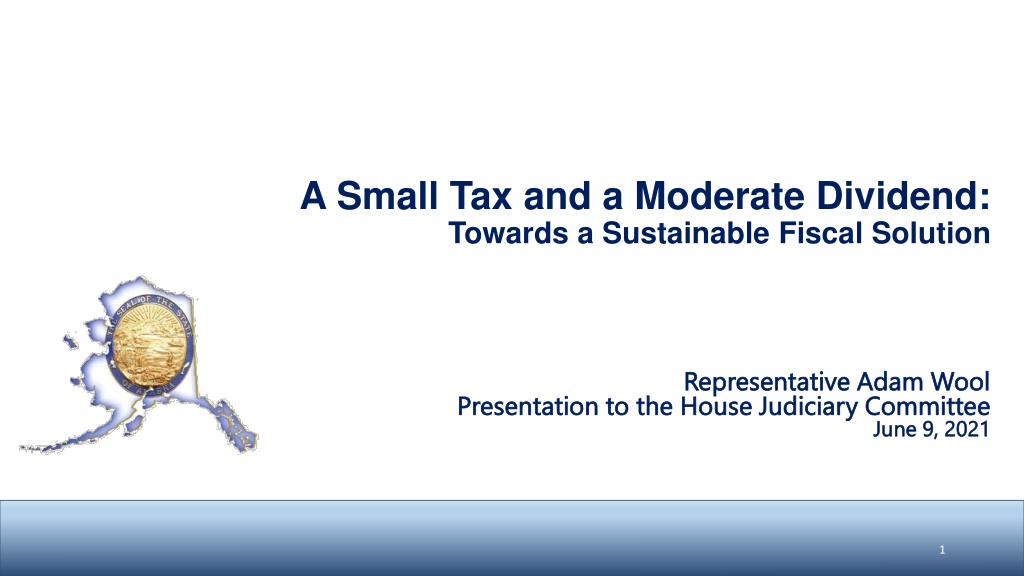

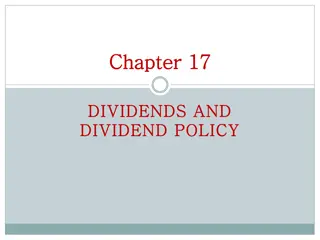

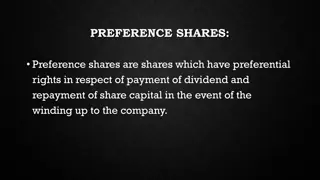
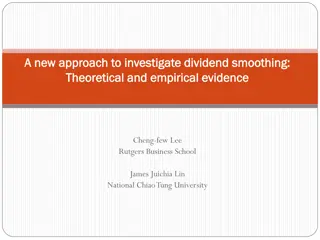
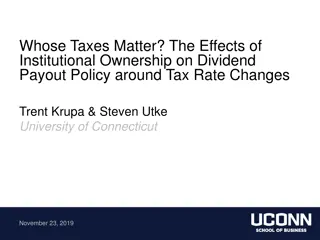
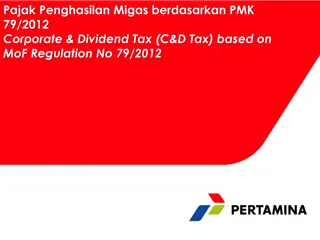
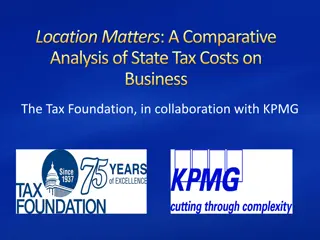
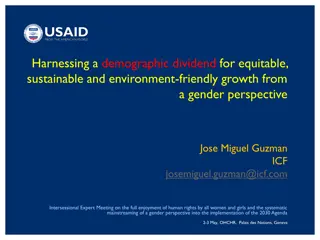

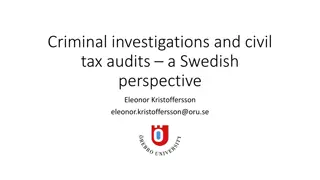
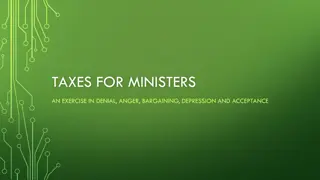

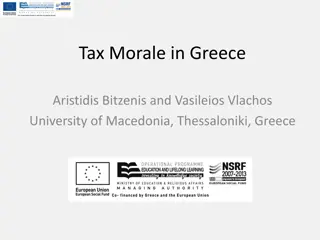
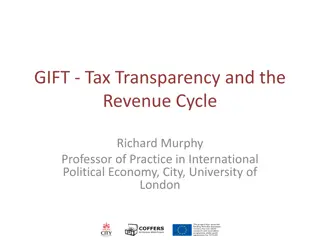
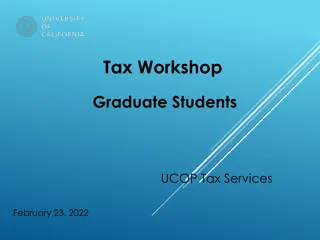
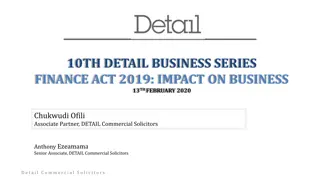
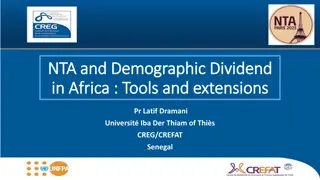

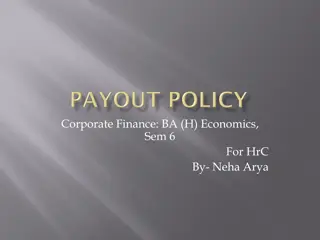
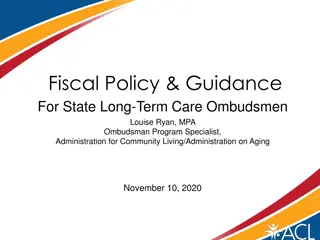
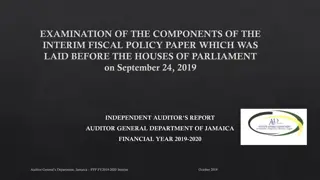
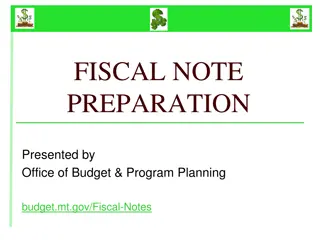
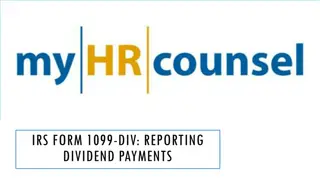
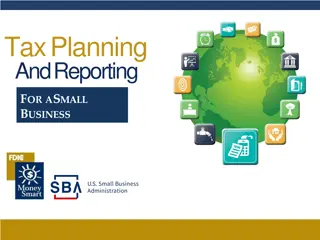


![Town of [Town Name] Real Estate Tax Rates and FY 2024 Budget Summary](/thumb/62211/town-of-town-name-real-estate-tax-rates-and-fy-2024-budget-summary.jpg)
